What Is The Best Bridge Camera With Zoom?
Inside: Find the best superzoom cameras for birding and easily select the one that fits your birdwatching style, requirements, and upkeep. I reveal the key features to await for in a bridge camera with superzoom capability forth with actual photos I took with each superzoom camera I reviewed.
Have you started shopping for a superzoom camera? It's overwhelming, isn't information technology? So many models to choose from with dissimilar zoom ranges and other features you may not take heard of before. Information technology's hard to know what features are important and which ones you don't need to pay attention to.
That'south how I felt when I started shopping for a bridge camera to take zoomed-in photos of the birds in my thou. The more I learned about cameras with superzoom for birding, the less confident I felt nearly buying one. Something was missing.
It was this frustration and absenteeism of real data that motivated me to inquiry superzoom cameras myself. Improve even so, I decided to buy each camera, have pictures with each photographic camera, and examination the cameras like I was using them to take pictures of birds.
I'm sharing everything I learned with you as well as the results of my testing – including actual photos taken with the cameras! I'll get more into it in a minute but outset, permit me share with you lot the all-time superzoom camera for birding.
Quick Navigation
- The Best Superzoom Camera for Birding
- The Best Superzoom Span Camera According to Whom?
- What is a Superzoom Camera?
- Superzoom vs DSLR vs Mirrorless vs Bridge
- DSLR Camera
- Mirrorless Cameras
- Span Cameras
- Key Features for a Bird Photography Photographic camera
- Superzoom Camera Dainty-to-Take (simply not Essential) Features for Bird Photography
- How I Reviewed the Superzoom Cameras
- Go along Your Distance When Photographing Birds
- Nikon COOLPIX P950 Review for Birding
- Key Features
- Pros & Cons
- Nikon Coolpix P950 Test Observations
- More Nikon Coolpix P950 Images
- Nikon COOLPIX P1000 Review for Birding
- Central Features
- Pros & Cons
- Nikon Coolpix P1000 Examination Observations
- More Nikon Coolpix P1000 Sample Images
- Canon PowerShot SX70 HS Review for Birding
- Key Features
- Pros & Cons
- Canon PowerShot SX70 HS Test Observations
- More Canon PowerShot SX70HS Sample Images
- Panasonic Lumix FZ80 Review for Birding
- Primal Features
- Pros & Cons
- Panasonic Lumix FZ80 Test Observations
- More Panasonic Lumix FZ80 Sample Images
- Sony CyberShot RX10IV Review for Birding
- Key Features
- Pros & Cons
- Sony CyberShot RX10IV Test Observations
- More than Sony CyberShot RX10IV Sample Images
- Frequently Asked Questions
- How is Bird Photography Different from Other Types of Photography?
- What's the all-time time to sentry birds?
- How Tin You Tell if a Camera Lens is Zoomed?
- The Canon SX70 vs Nikon P950 – Which Camera is Amend for Birding?
- Conclusion
The Best Superzoom Camera for Birding
To consider a bridge camera for birding it should take an extremely high optical adequacy (i.eastward. superzoom), fast autofocus, an image stabilization feature, fast frame capture charge per unit, and a minimum sensor size of 1/2.3″.
The all-time superzoom span camera for birding is the Nikon Coolpix P950 camera. With an optical zoom of 83x to get close up to the birds, fast autofocus to capture fidgety subjects, epitome stabilization to foreclose mistiness, a frame capture rate of 25 fps to provide lots of keeper photos, and a 1/2.iii″ sensor, it'south the perfect combination of features inside a camera body that fits comfortably in your hands.
That said, at that place are other worthy superzoom bridge cameras to buy for birding. I'll hash out those shortly.
The Best Superzoom Bridge Camera According to Whom?
The Nikon Coolpix P1000 has the largest zoom capability of any superzoom camera available – a whopping 165x! Simply what does that mean? If the other betoken-and-shoot superzooms merely have 50x or 60x zoom, is 165x overkill? Is 50x or 60x not plenty?
Some manufacturers tout the fastest autofocus on this side of the Mississippi! That'south cracking, merely is it fast enough to capture a fidgety bird? Is slower autofocus perfectly fine? I had to utilize the cameras in a natural setting in society to know for certain.
The "experts" say most bridge cameras have a sensor that'south too small to produce a quality epitome. Just what's that mean? My thought of quality may exist different from the trained eye of a professional photographer. Or your thought of quality for that matter. I included the pictures I took within the reviews and so yous can decide for yourself.
I'm not a professional photographer but I understand digital photography and have been photographing birds for my personal enjoyment for more than 15 years.
I was excited to test the superzoom cameras for birding and provide you with practical data based on real, easily-on experience actually using the cameras so yous can feel confident if you lot determine to purchase one.
Let's go started with some background on photographic camera types, how to cull a superzoom photographic camera for birding, and how I selected and reviewed the superzoom cameras for birding.
Short on fourth dimension? Skip right to the reviews!
What is a Superzoom Photographic camera?
A superzoom camera is a type of bridge photographic camera that has very loftier optical zoom adequacy. Some manufacturers and photography experts utilize different terms to refer to these types of cameras including long zoom, big optical zoom, bridge zoom, and hyper zoom
Superzoom cameras are a great choice because they offer an affordable camera pick with loftier zoom capability and great quality without the weight and majority. Compared with a professional person photographic camera setup that includes the DSLR body and high zoom lens, superzoom cameras are smaller, lighter, and considerably less expensive. They're ideal for people getting into wildlife photography as well as professionals that don't want to comport a large, heavy setup into the woods.
In my inquiry, I did not notice a definitive number that qualifies information technology to be a superzoom vs. a regular one-time standard zoom. For the purposes of photographing birds, I looked at cameras with a minimum optical zoom of 25x.
Superzoom vs DSLR vs Mirrorless vs Bridge
There are 3 primary types of digital cameras: DSLR, Mirrorless, and Bridge. Below is a cursory summary of each type.
DSLR Camera
The DSLR (Digital Unmarried-Lens Reflex) camera is usually used by professional person photographers. They consist of a camera body and interchangeable lenses.
DSLRs rely on a mirror within the camera body to capture the light and direct the prototype to the viewfinder. This enables the photographer to see exactly what the image will look like.
Mirrorless Cameras
The Mirrorless camera is similar to the DSLR in that it has interchangeable lenses. It differs from DSLRs in that information technology doesn't have a mirror. This enables a mirrorless camera to be smaller and lighter than the DSLR.
As well, the image displayed to the photographer in the viewfinder and screen (if it has ane) is an approximation of what the image will look like rather than exactly what it will wait like.
Bridge Cameras
The bridge photographic camera, also known as a bespeak-and-shoot, consists of the camera body and lens congenital into one unit of measurement. They're also referred to equally SLR-Manner Compact.
Span cameras may have many manual settings bachelor for the lensman to flex her creative side but are also known for preset modes so the novice tin immediately brainstorm shooting pics simply by setting the dial (for example) to "Bird" mode.
Every bit mentioned earlier, superzooms are bridge (or point-and-shoot) cameras.
Primal Features for a Bird Photography Camera
Bird photography is unique from other types of photography in that birds are tiny, fidgety, fly away without notice, and often make their advent in the early morning and late afternoon when lighting is low – again, without observe.
When choosing a bridge camera with superzoom capability for bird photography at that place are a few key features the camera must have to help us take great close-up pictures of the birds. They are:
- Optical Zoom (Hi Superzoom!)
- Auto Focus
- Image Stabilization
- Frame Capture Charge per unit
- Sensor Size
Combined, the above key features work together to provide great paradigm quality and a clear and in-focus shut-up of the bird. After all, that is what we want, right? Keen close-up pictures of birds!
Allow's have a expect at each of these features and learn why they made the "key features" list.
Optical zoom refers to the photographic camera lens' ability to become close to the subject – the birds. The higher the optical zoom the closer nosotros can get to the bird which is crucial. Note: Digital zoom is a fancy way of referring to zooming in on the photo. You can disregard digital zoom considering it doesn't ameliorate epitome quality – in fact, information technology introduces dissonance which results in poorer quality. I disabled digital zoom while testing the cameras in my review to ensure I was assessing optical zoom alone.
Autofocus: We meet a bird, take hold of our camera, get it in the frame, zoom in, press the shutter ½ manner to auto-focus, and click! A beautifully focused close-up of the bird. Or so we hope.
A fast car-focus dramatically increases our chances of capturing that perfect shot.
With a slow auto-focus, our photo may show the tail end of the bird as information technology flies off! This is why auto-focus speed is and then of import.
All cameras come with an machine-focus feature, Some manufacturers state the auto-focus speed, usually in fractions of a second, while others practise not. By testing each superzoom camera myself I'm able to judge whether or not the photographic camera'south autofocus speed is suitable for bird photography.
Image Stabilization: Camera movement is a leading cause of blurred images. Image stabilization helps by reducing camera movement and is particularly important with span superzoom cameras because not simply is the lensman trying to concur the camera steady simply also the long, extended lens when it'due south zoomed out.
A monopod or tripod is besides useful but not always applied.
Auto-focus and image stabilization work together to produce an image that'southward in focus.
Frame Capture Rate (fps): Recall, our models (birds) are always on the become. Fifty-fifty while perching they may be darting their bodies here and there. For that reason, information technology's helpful to enable the camera's continuous mode which captures photos continuously versus one at a fourth dimension. The multiple shots let yous to cull from a variety of images in hopes of at least one existence the perfect pic.
Sensor Size: The job of the camera sensor is to capture the photons (light particles) that hitting it and convert them to an electrical signal that the camera's processor reads and forms into an epitome.
The camera sensor is important because information technology is a key gene that determines image quality. The bigger the sensor, the better the image quality.
However, as I alluded to in my introduction, your idea of great image quality may differ from mine and that of the seasoned professional photographer. So I invite you to be the judge. Review the sample photos I provide in this commodity and decide – is the prototype quality skillful enough for you?
That said, the majority of the cameras I reviewed have the same sensor – i/2.3″ (6.ii x 4.6mm) BSI CMOS.
What about Megapixels?
Time to bosom the myth "More megapixels are better."
Note: The number of megapixels your camera has is important when having large prints made of your paradigm. If you're taking pics of birds to frame and hang a ten" x 20" photo on your wall, more megapixels may be ameliorate for you. For the rest of united states, keep reading…
Remember when camera and smartphone manufacturers were regularly raising the bar in the megapixels section? Information technology led united states of america to believe that more megapixels are better.
While this may have been truthful back so when the average camera sported 4MP, it no longer is true. Today, fifty-fifty a photographic camera with 12 MP is more than than enough for most of us.
This is corking news because in general, the higher the megapixel the slower the camera becomes at other tasks such as auto-focusing and continuous shooting – 2 key features for bird photography.
From an paradigm quality perspective, the sensor size is a far better guess of image quality than megapixels.
Superzoom Camera Nice-to-Have (just non Essential) Features for Bird Photography
The features and attributes below are overnice-to-haveastward andmay heighten your experience or meet a personal preference, but are not deal-breakers for shooting pics of birds. Review the list and if something is personally important to you, make notation of it.
- Size & Weight – Superzoom cameras come in a variety of sizes and weights. If you'll be hiking great distances or just prefer a smaller, lighter camera, look for one that meets this need.
- Battery Life – Some batteries last longer than others. If you are hands annoyed by having to switch batteries when spending the 24-hour interval with nature, look for a camera with longer battery life.
- Price – Superzoom cameras range in price anywhere from $300 to $2,000. The less expensive cameras oftentimes mean you're giving something up – but non ever. Read my reviews carefully and decide for yourself if the more expensive camera is worth it.
- Bird Fashion – Many cameras come with predefined "scene" modes where you easily switch to them and all exposure settings are automatically gear up. Bird mode is one such scene mode. If you're new to photography or just don't want to deal with transmission settings, look for a camera with a Bird way.
- Durability – More than durable cameras enable you to get thick in the woods without fear of damage. A well-cushioned photographic camera bag can also help protect the cameras when not actively snapping pics. Decide if this is an of import feature for you lot.
- Waterproof – Plan on taking photos in the rain or snow? Look for a waterproof camera if this is a concern.
- Video – Most if not all cameras are video-capable these days. If video is or will be part of your photography life, make sure the camera has the latest and greatest format – 4K.
- Audio – Same as video, if you intend to capture audio of your videos make sure this feature is available.
- Paradigm Sharing – Nowadays many people desire to hands share their images on line. If simple prototype sharing adequacy is important to you, be sure to check out the camera's capability for information technology.
- RAW Image Format – If y'all programme to practice some backroom editing (e.g. with Lightroom or PhotoShop), you'll desire to accept photos in RAW format. All cameras shoot in JPG format but not all support RAW. If this is important for you lot make sure RAW is supported.
- Connections (Wi-FI, Bluetooth, HDMI, USB) – Make up one's mind what you program to exercise with your amazing bird photos. And then determine how the photos will get in that location. Pop options include: Transfer to computer via Wi-Fi, USB cablevision, or Bluetooth. Transfer to a smartphone (to share online) via Wi-Fi, app, or Bluetooth. Show on TV or monitor via HDMI cable. Don't have Wi-FI? Brand sure the camera has Bluetooth capability.
How I Reviewed the Superzoom Cameras
I purchased and tested each of the superzoom cameras I reviewed. The same tests were performed with each camera and then they could exist assessed equally.
Kickoff, I took several photos of a static subject (wooden cardinal below) at full-zoom, without support (e.g. handheld) from distances of 15, 25, 50, and 75 anxiety from the subject.
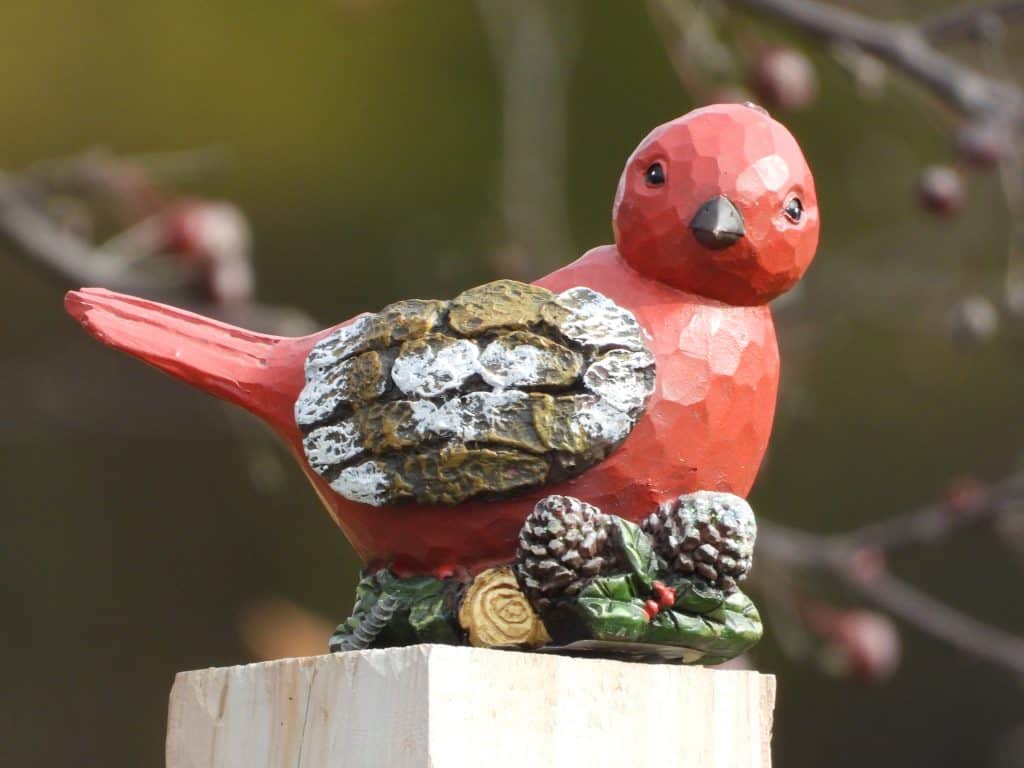
This allowed me to determine if the superzoom camera was up to the chore of zooming in close enough to capture upwards-close images of birds in a real-life scenario.
Annotation: Because the fundamental is fabricated of woods with definitive edges, non soft feathers, the quality is going to be meliorate than a existent bird. For that reason, I didn't utilize distance tests to determine image quality. Information technology wouldn't exist fair.
Then I spent time using the cameras naturally, taking pics of birds around my yard and beyond.
I was mindful of how quickly the auto-focus was able to find a articulate shot of the bird. How often I was able to capture the bird earlier it flew away and how often I wasn't.
Using the continuous shooting features I wanted to be sure it was fast enough to capture plenty pics of the bird (from perching to flight away) so I was left with several choice shots to choose from.
Finally, I analyzed the photos for paradigm quality.
Proceed Your Distance When Photographing Birds
In order to appraise the cameras equitably, I needed to examination using the same distances from the birds. But simply how close should you be to a bird when taking pictures?
When photographing birds you should never be so close that they find you (e.g. they appear spooked or rattled and fly away). The actual distance varies depending on how well you're curtained by trees and shrubs, the brightness of your clothing, and the noise made by your camera, but 25′ abroad from the bird is the minimum.
The National Audubon Society suggests we keep enough of a distance that allows our subjects to behave naturally.
Also that, if y'all're also close to the bird information technology's going to fly away and you go no shot.
Thinking about my own experience with birds in my yard, a distance of 50' generally assures the bird hasn't noticed me. If the bird approached me, I may be between 15-25' away. If I'm taking pics through a window in my house, the distance is about 15'. In larger yards or out in the wild a distance of 75' (minimum) is likely needed.
By testing the 4 distances (15, 25, 50, and 75 anxiety) I felt many bird run into scenarios were covered helping y'all to make the all-time superzoom camera option depending on how y'all typically shoot photos of birds.
Now, let'south go to the adept stuff – the reviews!
Nikon COOLPIX P950 Review for Birding
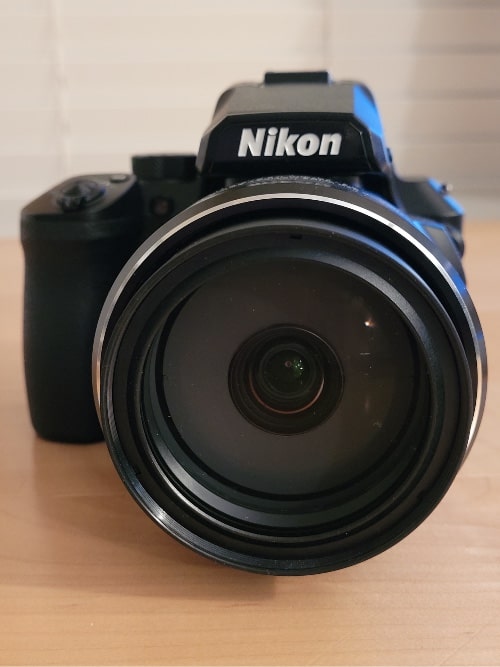
The Nikon Coolpix P950 is an fantabulous camera with an optical zoom of 83x that blows abroad all the competition with the exception of its older blood brother – the Nikon Coolpix P1000. Nevertheless – 83x is more than adequate zoom for birding.
Of all the cameras I bought and tested, I ended up keeping the Nikon Coolpix P950 and love it!
The P950 is ideal for the birder who wants extreme zoom adequacy, and dandy epitome quality, just in a slightly smaller & lighter body.
If y'all're on the fence about the P1000 due to its weight or size, the P950 is for you. The P950 is smaller only nevertheless boasts its 2000mm focal length to capture the tiniest bird.
It's less expensive than the P1000 (past about $200) and the focal length drops from 3000mm to 2000mm – but still, y'all're getting 83x zoom! (Encounter a comparison of the two COOLPIX cameras below)
Nikon COOLPIX P950 vs P1000 Comparing
| Nikon P950 | Nikon P1000 | |
| Weight | 2.2 # | three.1# |
| Size | 5.half dozen x 4.4 x five.9 " | 5.eight x iv.7 x 7.2 " |
| Zoom | 83x | 125x |
| Cost | $$$$ | $$$ |
Fundamental Features
| Make & Model | Nikon Coolpix P950 |
| Optical Zoom | 83x |
| Auto Focus | Fast |
| Image Stabilization | Yeah |
| Frame Capture Rate | 25 fps |
| Sensor | one/two.3″ (6.2 x iv.6mm) CMOS |
Pros & Cons
Pros
- Amazing optical zoom (83x) to become those close-ups.
- Excellent epitome quality.
- Fast autofocus speed so you don't miss the shot.
- Easy to use with Bird mode, so you tin offset shooting pics right away.
- Multi-directional monitor, and so you can easily size upwards the shot.
Cons
- Heavier than the other superzooms I tested.
- A stability device such equally a monopod or tripod is needed when using full zoom.
Nikon Coolpix P950 Test Observations
When the camera arrived I immediately opened information technology, installed batteries & a memory card, set it to Bird fashion, and started shooting. It was that fast and like shooting fish in a barrel. And, it felt comfortable in my easily.
Optical Zoom Distance Test
Below are the results of the distance testing with the camera at full zoom.
With the shooting mode set to continuous, I was able to capture many bang-up shots each fourth dimension.
I plant the autofocus speed to be very quick, which is essential for bird photography.
The Nikon Coolpix P950 was noticeably lighter and smaller than the P1000. Keep in listen this camera has an optical zoom of 83x so information technology needs larger housing and some weight to comprise this lens.
In other words, you lot get a phenomenal optical zoom reach with the P950 and take to expect some type of merchandise-off. In this case, it'south a camera that'southward a fleck larger and heavier than the others. Still, it'south MUCH lighter and smaller than a DSLR setup with a comparable zoom lens.
It really comes down to personal preference. Afterwards purchasing and testing both the Nikon Coolpix P950 & P1000 superzoom cameras, I opted to continue the Nikon Coolpix P950 considering it was lighter and smaller.
Tammy Poppie
At full zoom, the Nikon Coolpix P950 requires a monopod or tripod for most people.
Alternatively, be sure to enable the camera'south image stabilization. Nikon's organization is referred to as a Dual Detect Optical Vibration Reduction system. It works to stabilize both horizontal and vertical movements and works great. I shot all my pics freehand.
More Nikon Coolpix P950 Images
Below are boosted photos taken with the Nikon Coolpix P950. They're unedited and perhaps not the best in terms of composition just provide a sample of the photographic camera's image quality and zoom.
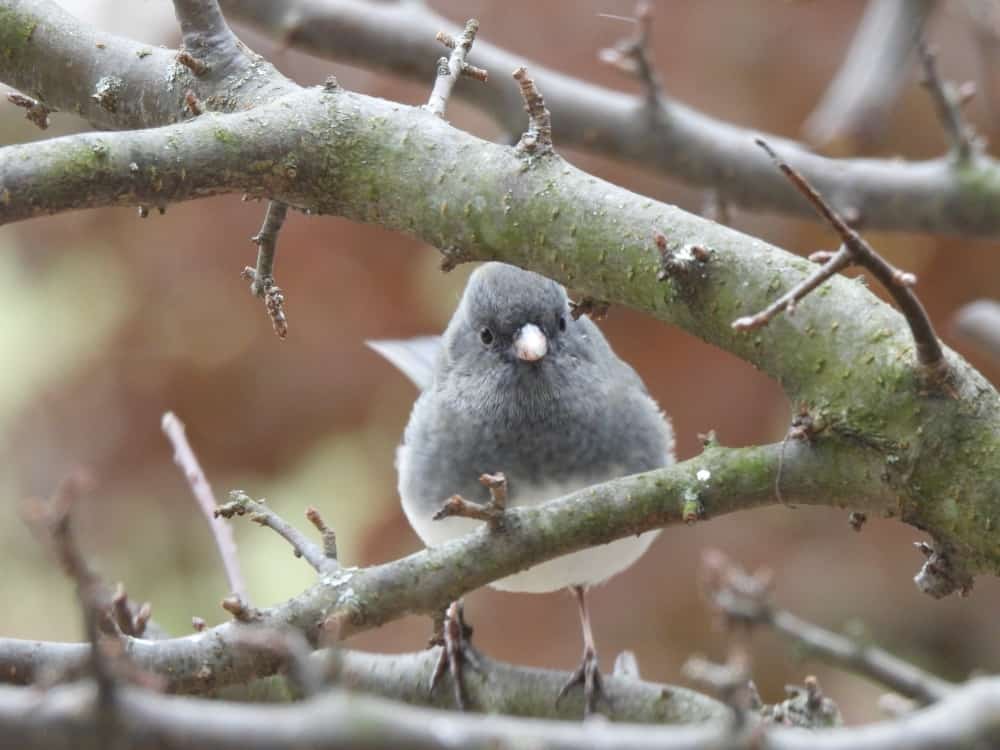
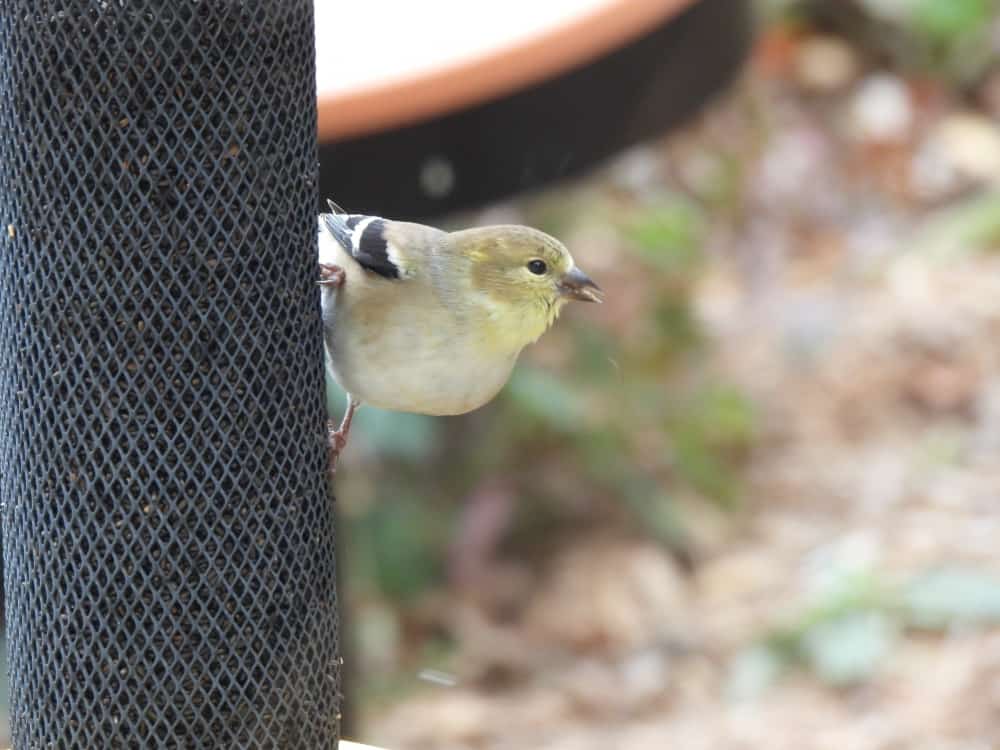
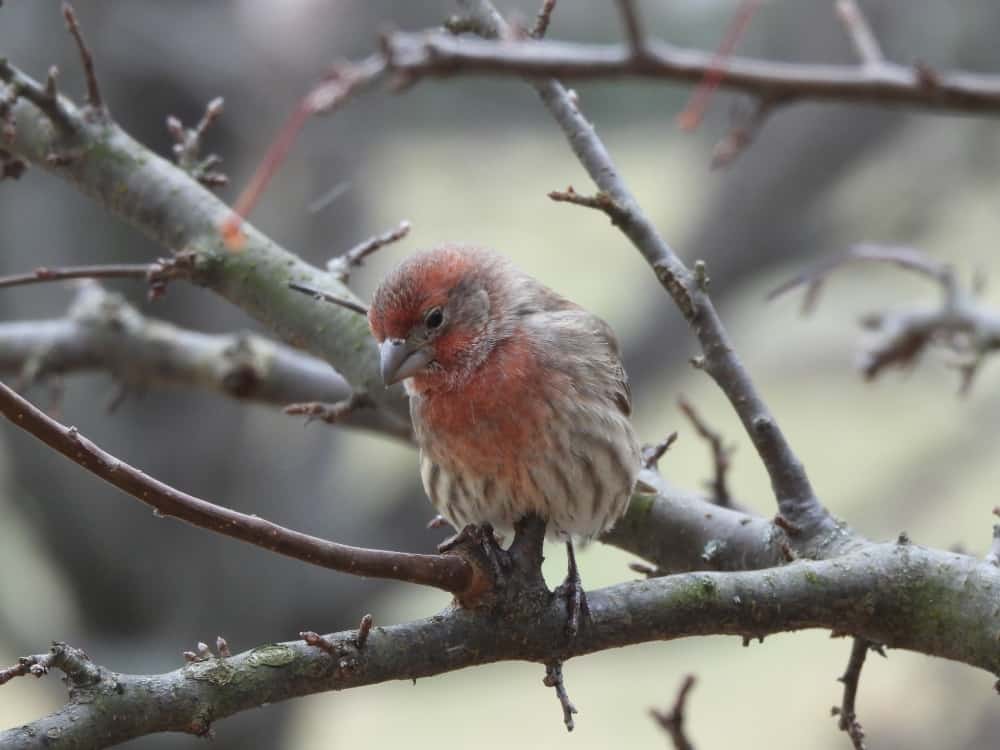
Nikon COOLPIX P1000 Review for Birding
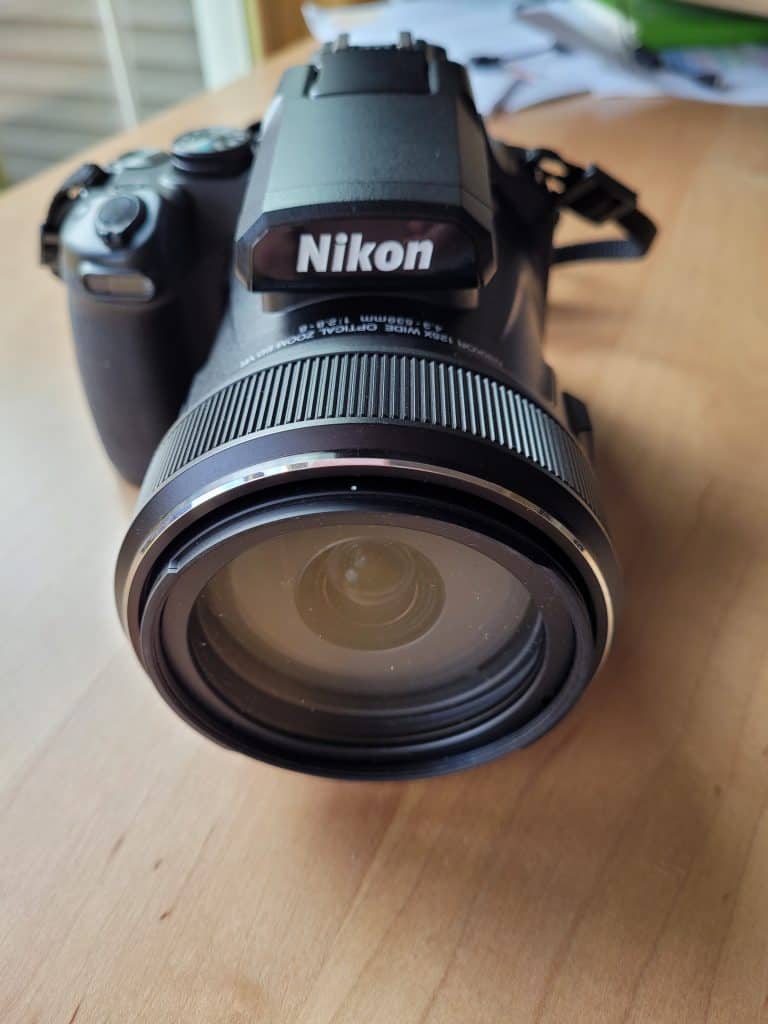
The Nikon Coolpix P1000 is an excellent camera with a listen-blowing optical zoom capability – 125x! However, information technology's a large and relatively heavy photographic camera.
It'south ideal for the birder who won't settle for less than the maximum zoom capability and demands slap-up image quality – even at full zoom from 100′ away.
It's one of the highest-priced cameras in the superzoom category simply with 125x optical zoom it'southward withal thousands of dollars less than a DLSR or Mirrorless fastened to a telephoto zoom lens. And, it's lighter!
Primal Features
| Make & Model | Nikon Coolpix P1000 |
| Optical Zoom | 125x |
| Auto Focus | Fast |
| Image Stabilization | Yes |
| Frame Capture Rate | 7 fps |
| Sensor | 1/2.3″ (6.two x 4.6mm) CMOS |
Pros & Cons
Pros
- Astounding optical zoom (125x) to get those close-ups even when 100+ feet away.
- First-class image quality near and far (100' +) for greater versatility.
- Fast autofocus speed so yous don't miss the shot.
- Like shooting fish in a barrel to use so you tin can start shooting pics right away.
- Multi-directional monitor, then y'all can hands size up the shot.
Cons
- Information technology's the heaviest superzoom bridge camera available.
- A stability device such as a monopod or tripod is needed for greater distances using full optical zoom.
Nikon Coolpix P1000 Exam Observations
When the camera arrived I immediately opened it, installed batteries & a memory card, set up it to Bird mode, and started shooting. It was that fast and like shooting fish in a barrel. It was also heavier than I expected.
Optical Zoom Altitude Test
Below are the results of the altitude testing with the camera at total zoom.
I did not include a photo from a 15′ altitude considering the Nikon Coolpix P1000'southward optical zoom was also strong for the wooden bird at a short distance.
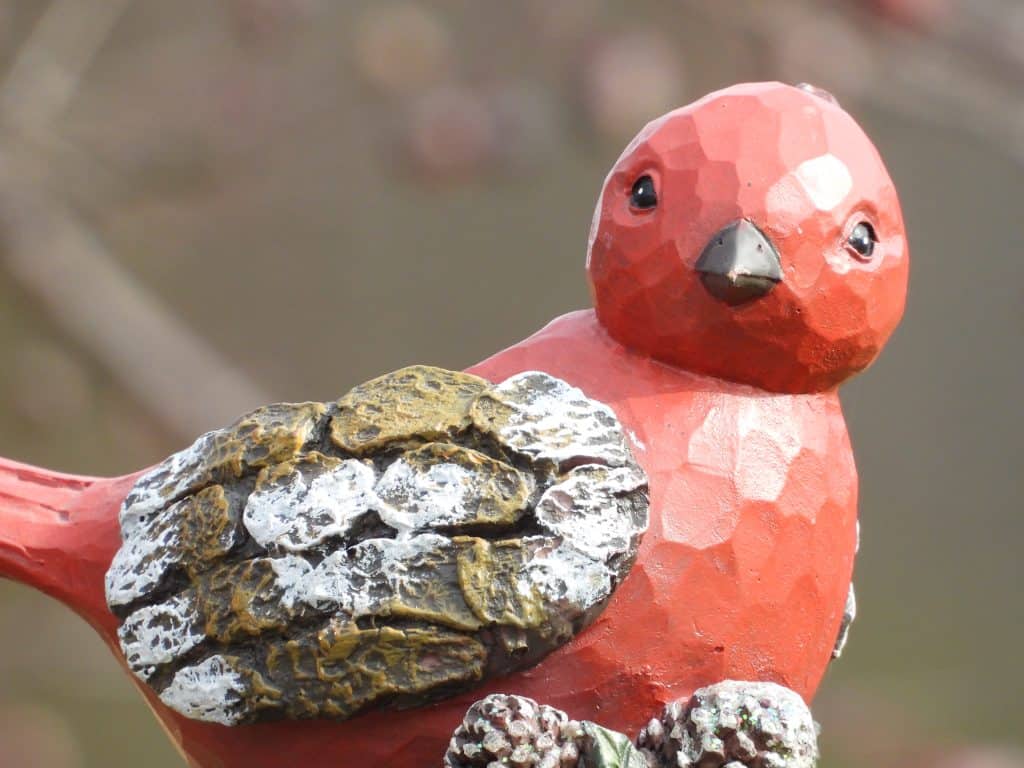
The Nikon Coolpix P1000 camera is up to the task of zooming in on birds far abroad. Check out the pic below taken more than more than 100' from the field of study!
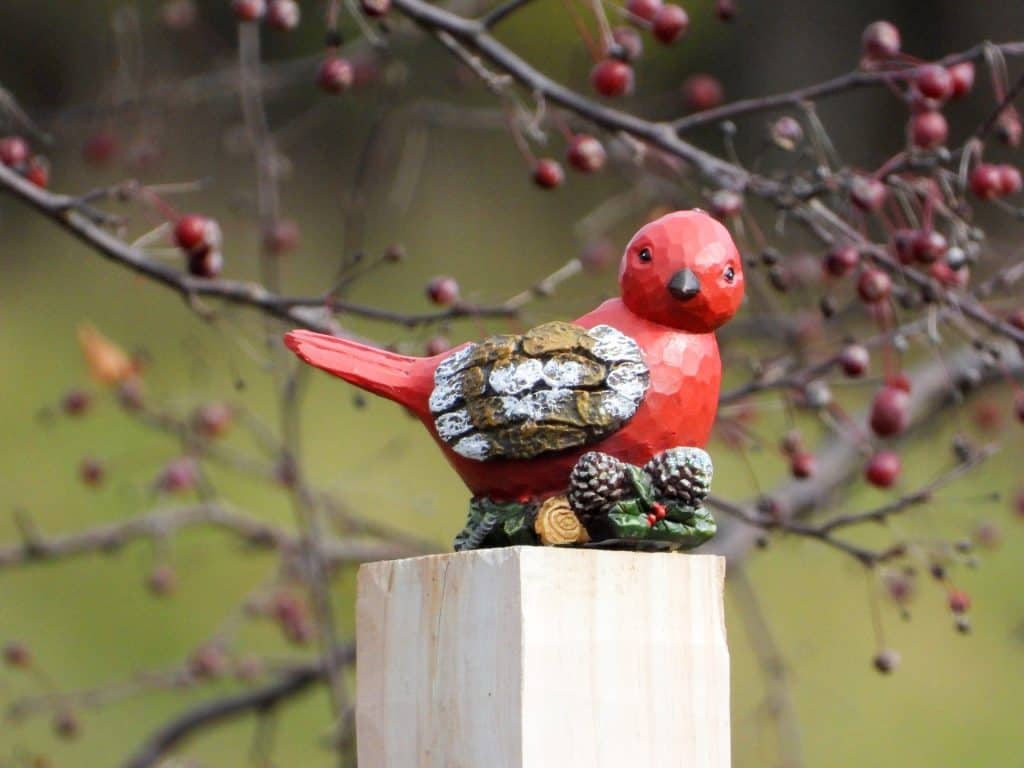
With the shooting mode gear up to continuous, I was able to capture more 10 nifty shots each time. Although it's not the fastest camera I tested (only 7fps), it was plenty fast for me.
And, because the quality of each shot was swell it didn't affair. In fact, I literally had a difficult time choosing the best shot. They were all that expert.
Nikon doesn't explicitly state the speed of the autofocus and I didn't get out a stopwatch and examination the bodily autofocus speed but constitute it to exist really fast.
I took the Nikon Coolpix P1000 to a nearby nature park and although information technology's the heaviest (3 lbs) and largest (v.8″ x 4.7″ x 7.1″) superzoom camera I tested, I felt like I was only carrying "a camera" vs. "a really heavy cumbersome camera". I recollect it boils down to personal preference.
Unless you're 1 of those people with a really steady manus, a monopod or tripod is needed for really far distances otherwise, the camera has trouble focusing on the subject due to camera motion.
The shots below were from a distance of more than 150' and total zoom. I had a hard fourth dimension keeping the photographic camera still enough to let the autofocus exercise its job.
That said, for the shots nether 100′ I actually appreciate the image stabilization on the P1000. I shot all of the pictures freehand and they're pretty articulate and crisp just would have been improve with a tripod or monopod.
More Nikon Coolpix P1000 Sample Images
Beneath are additional photos taken with the Nikon Coolpix P1000. They're unedited and perhaps non the best in terms of composition but provide a sample of the camera's image quality and zoom.
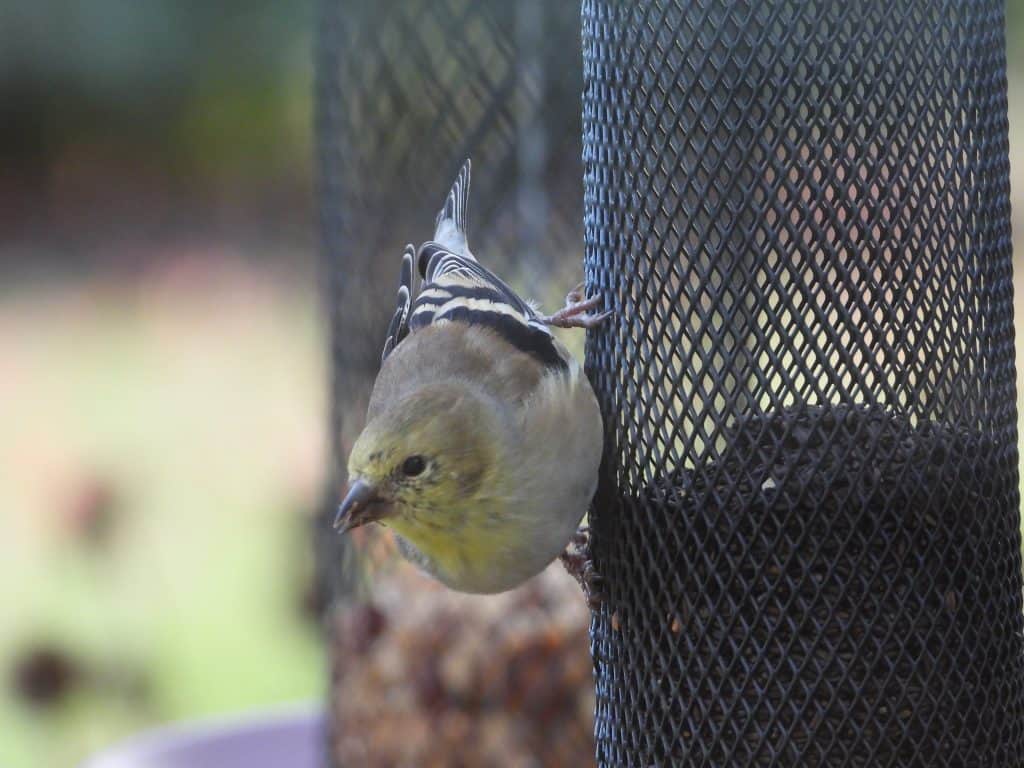
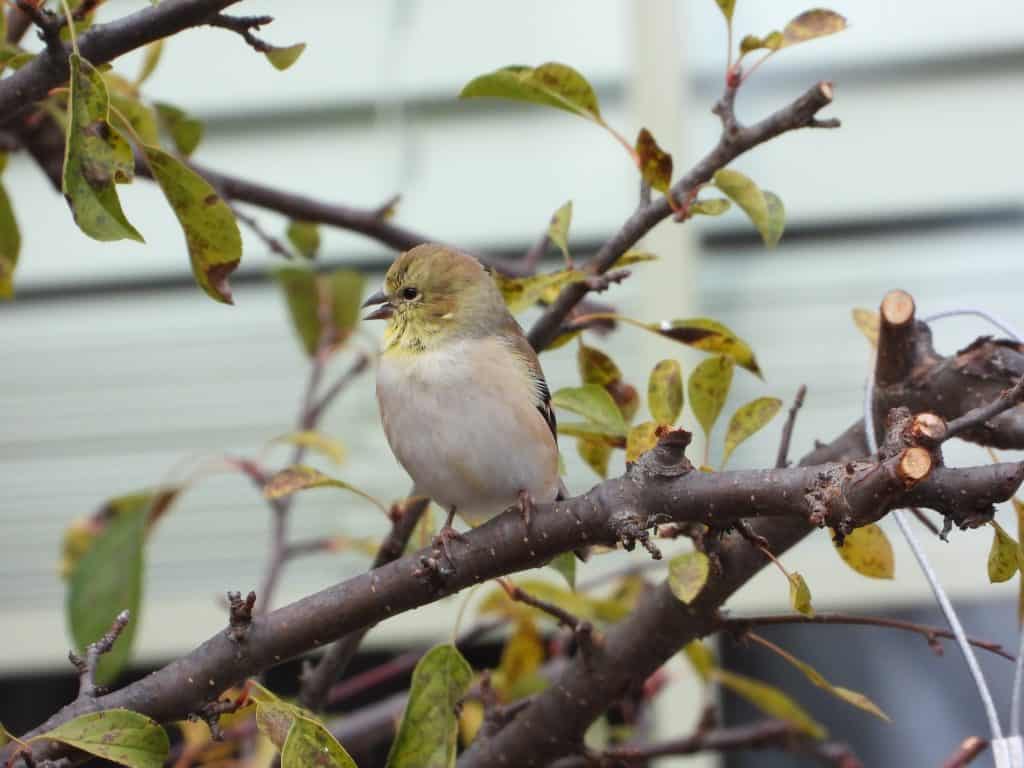
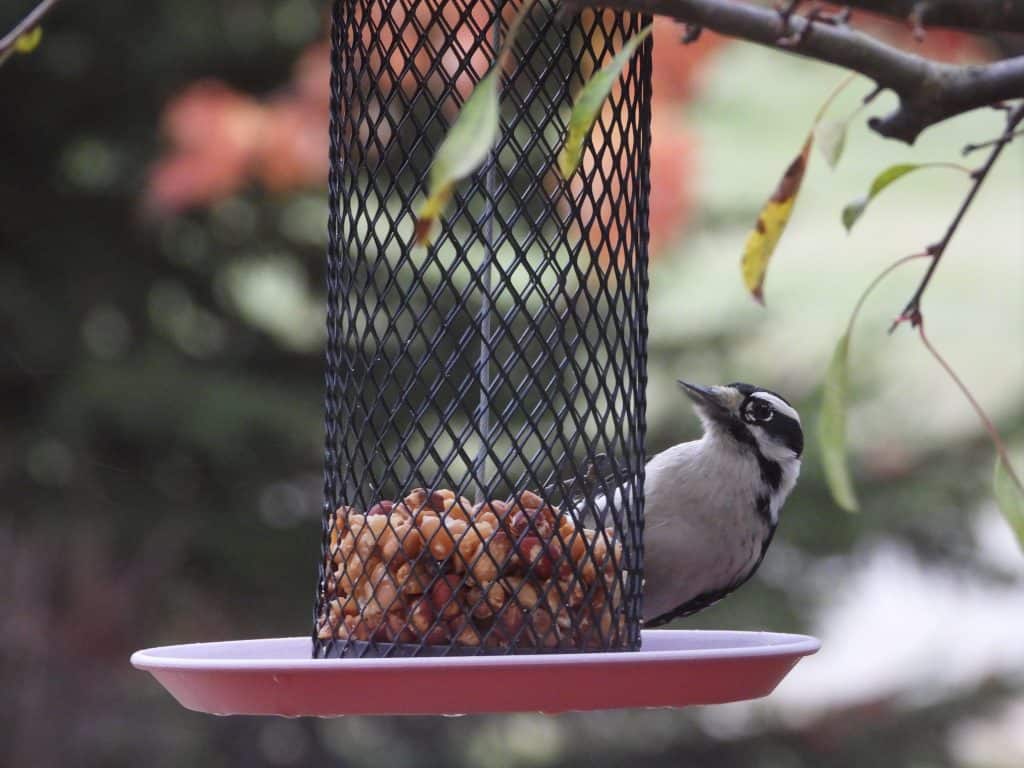
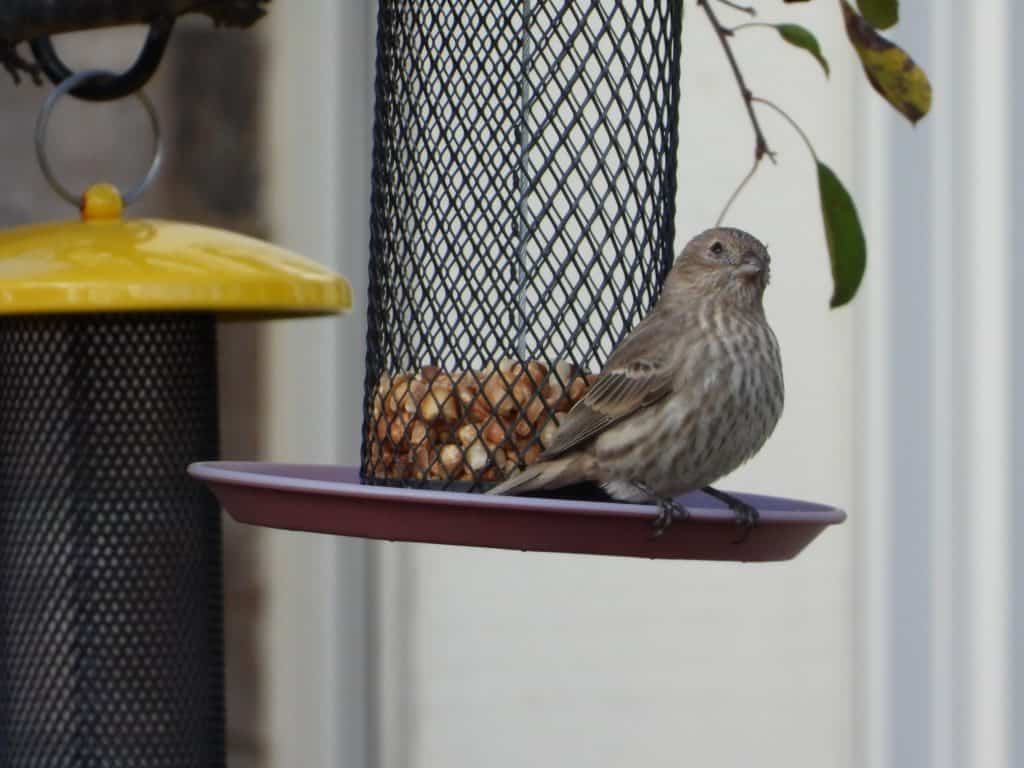
Canon PowerShot SX70 HS Review for Birding
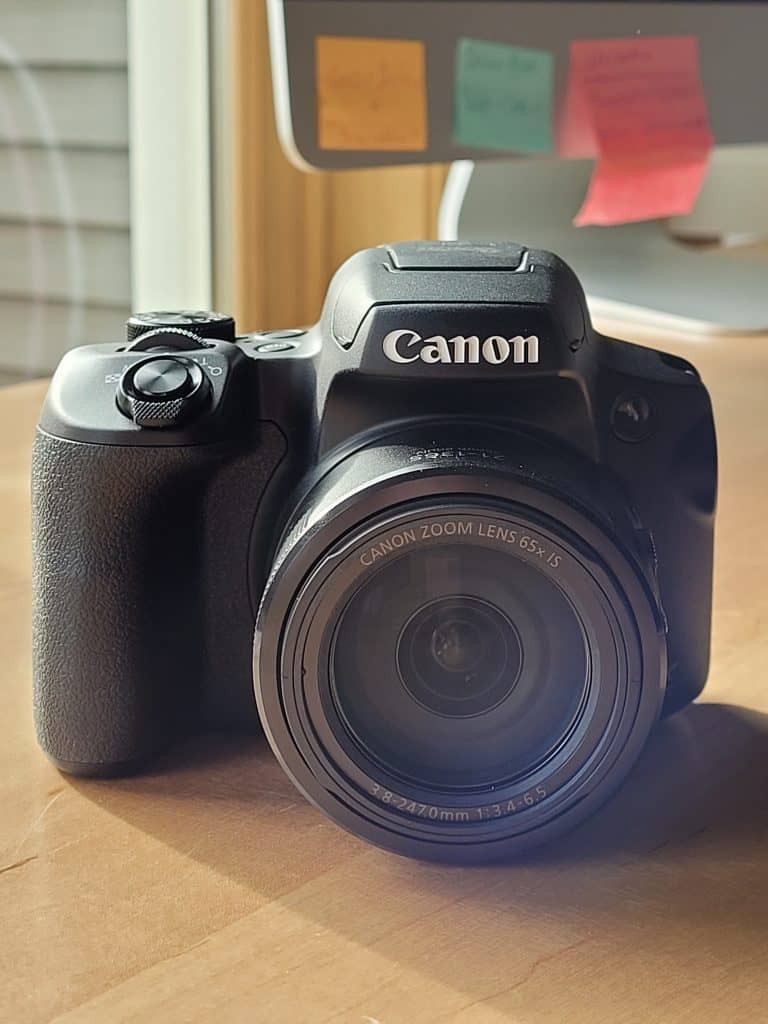
The Canon PowerShot SX70 HS is a fun camera with an impressive optical zoom of 65x. Information technology'due south ideal for the backyard birder that wants to exist able to zoom in close on birds on the feeder or nearby the deck/patio.
Compared with the Nikon Coolpix P950 and P1000, the Canon is much smaller, lighter, and less expensive. At well-nigh 1/ii the zoom capability of the Nikon Coolpix P1000 (125x) it all the same packs a punch and is more than adequate for birding.
When capturing shots of small birds, its sweet spot at full zoom is nearly 25′ or closer.
Key Features
| Brand & Model | Catechism PowerShot SX70 HS |
| Optical Zoom | 65x |
| Automobile Focus | Fast |
| Image Stabilization | Yep |
| Frame Capture Rate | 10 |
| Sensor | 1/ii.3″ (6.2 ten 4.6mm) BSI CMOS |
Pros & Cons
Pros
- Tremendous zoom capability (65x) to capture not bad shots of small birds shut up.
- Pocket-size & lightweight.
- Vari-angle monitor to easily prepare the shot.
- Great epitome quality.
Cons
- Doesn't take a Bird style so getting started was slower.
Catechism PowerShot SX70 HS Exam Observations
Later on unboxing and charging the battery information technology was ready to go. I did have to fiddle with the settings a scrap since it doesn't have a Bird way.
I was impressed with the prototype quality, especially zoomed in. The autofocus speed was lickety-split up. That combined with the fast prototype capture rate (10 fps), I didn't miss any shots.
The Catechism PowerShot SX70's viewfinder is large and I was able to swing the monitor out to the side, rotate 360, and place it dorsum in its compartment with the monitor facing outward. I found the flexiblemonitor really helpful when getting the shot gear up, reviewing information technology afterward, and navigating the camera's menu system.
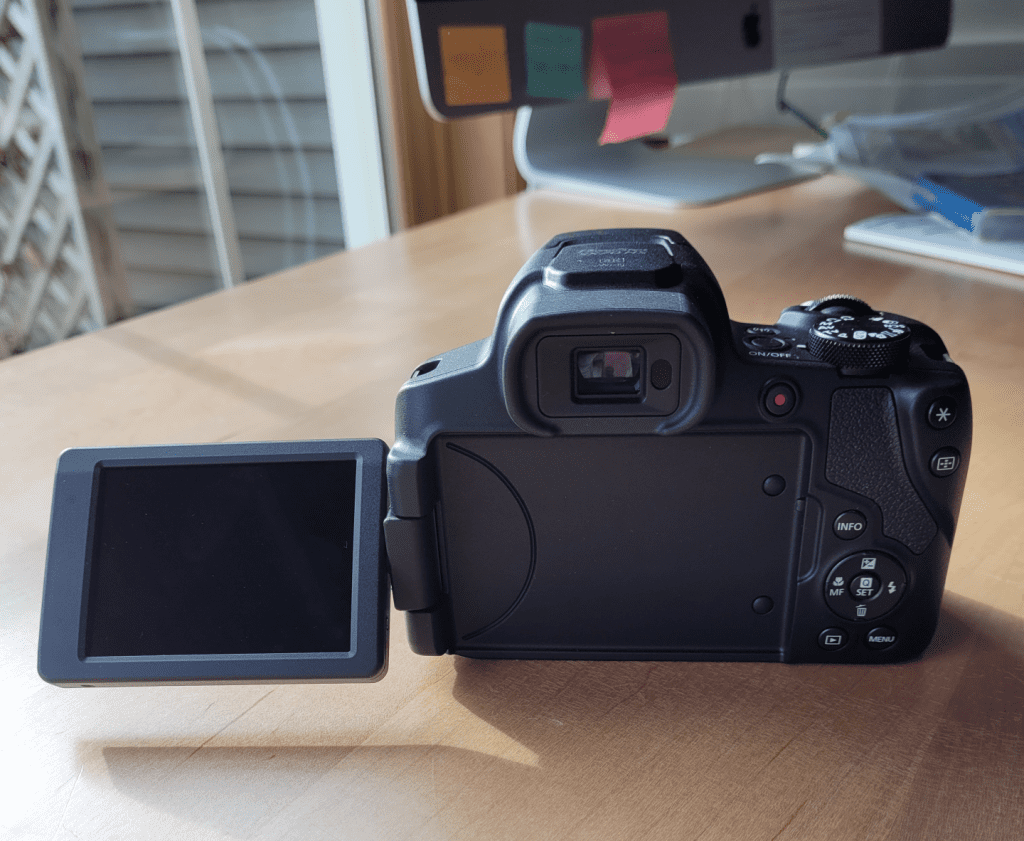
As you'll soon see, the image quality is really very skilful. Kudos to the prototype stabilization every bit most shots were very sharp and clear, fifty-fifty in total zoom, without a tripod or other stability method.
Optical Zoom Distance Test
Below are the results of the distance testing with the Canon PowerShot SX70 HS photographic camera at total zoom.
More than Canon PowerShot SX70HS Sample Images
Below are boosted photos taken with the Catechism PowerShot SX70HS. They're unedited and maybe not the best in terms of composition simply provide a sample of the camera's image quality and zoom. And yes, I like chickadees!
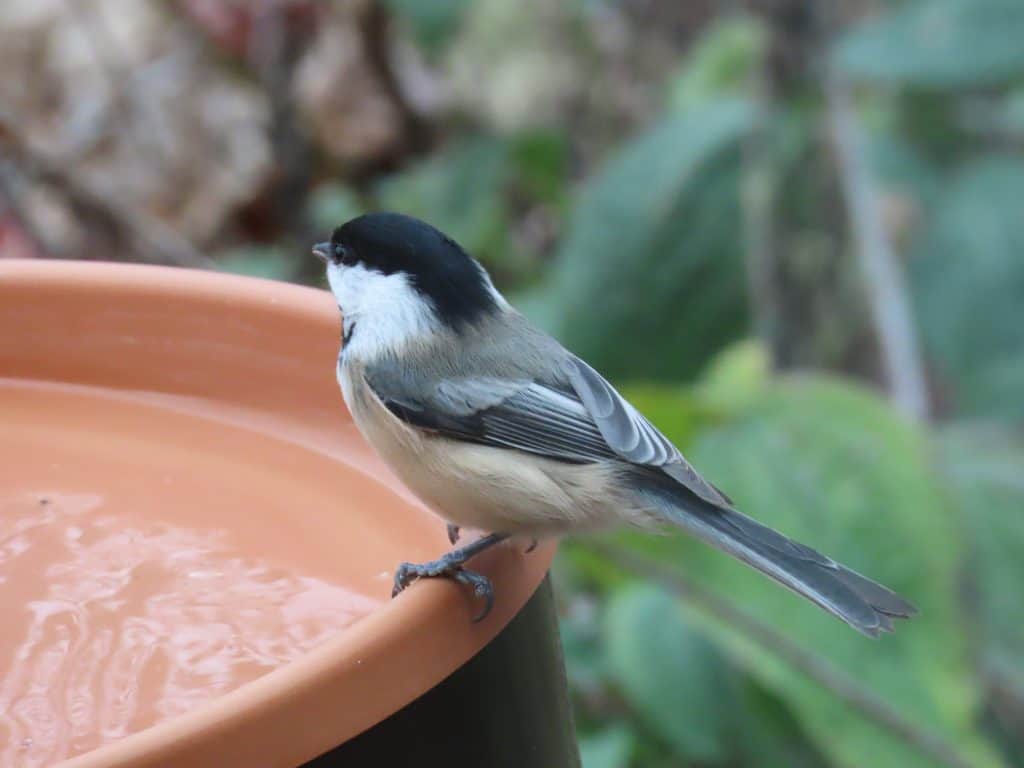
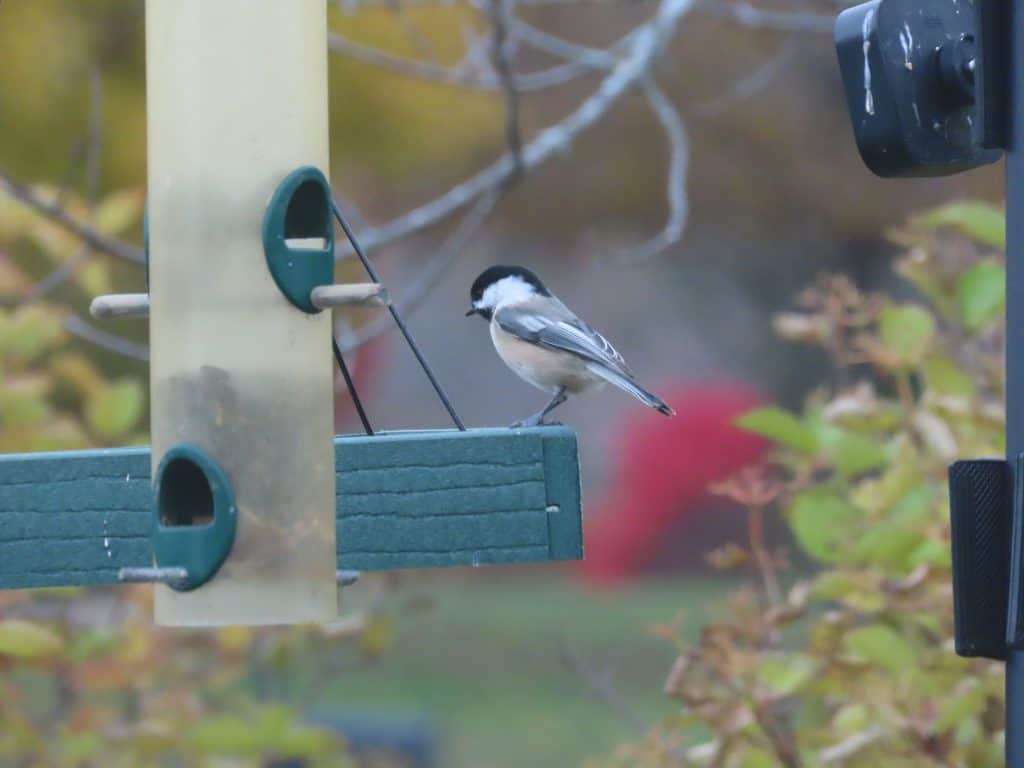
Black-capped chickadee. Photo was taken with Canon PowerShot SX70-HS 25′ away.
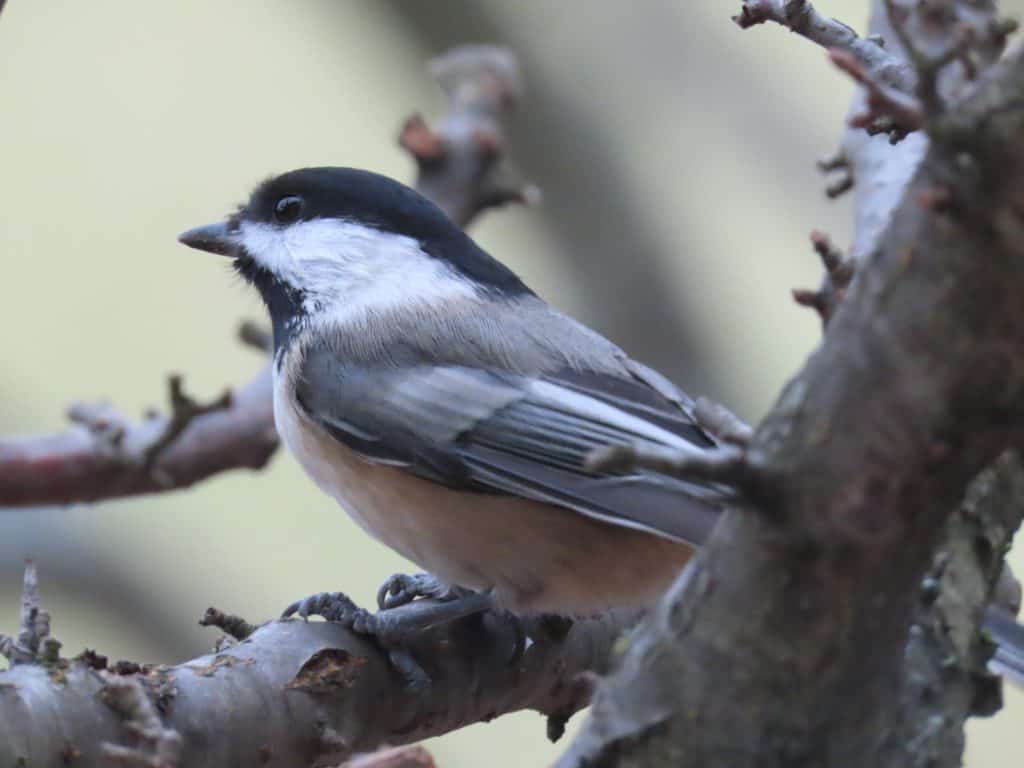
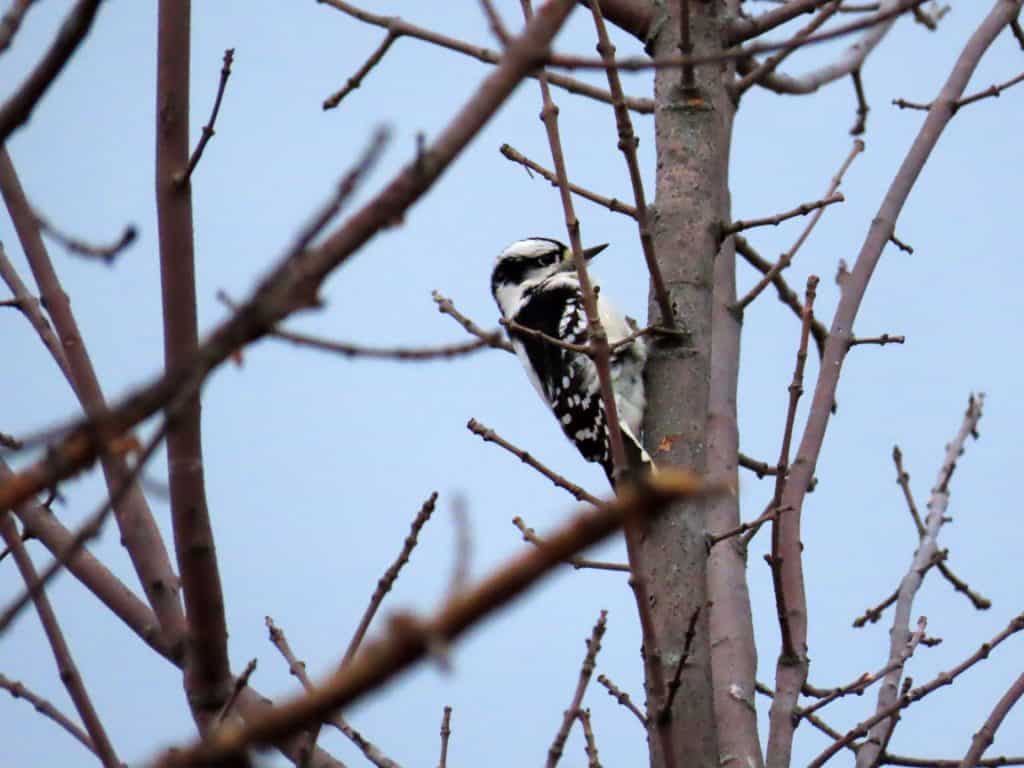
Panasonic Lumix FZ80 Review for Birding
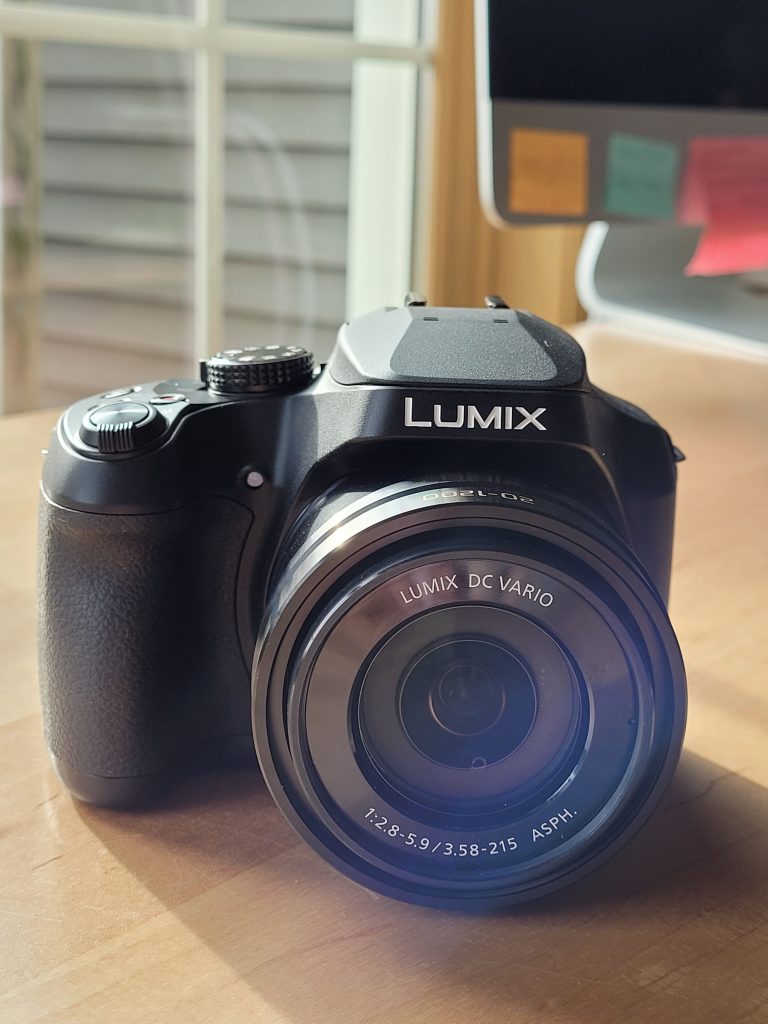
The Panasonic Lumix FZ80 is the ideal upkeep superzoom camera for the lawn birder that wants to capture bird closeups from the deck or patio and still get very-proficient quality images.
If yous prefer a camera on the smaller and lighter side and adopt to navigate the carte via touchscreen, this camera is for you.
When capturing shots of pocket-size birds at full zoom, its sweetness spot is about xv-20′ abroad.
Primal Features
| Make & Model | Panasonic Lumix FZ80 |
| Optical Zoom | 60x |
| Auto Focus | Quick |
| Prototype Stabilization | Aye |
| Frame Capture Charge per unit | 10 fps |
| Sensor | one/2.3″ (6.2 x 4.6mm) BSI CMOS |
Pros & Cons
Pros
- Good image quality when within 15' of the subject field.
- Good autofocus speed to focus on the bird quickly.
- Affect screen monitor to easily navigate the photographic camera menu options.
- Minor & light so it'south easy to carry anywhere.
Cons
- The viewfinder and monitor are too tiny to exist useful for gauging the shot (fifty-fifty from a shut distance or fully zoomed in).
- Image quality became soft around 20'.
- Doesn't have a Bird mode then getting started was slower.
Panasonic Lumix FZ80 Test Observations
The Panasonic Lumix FZ80 doesn't accept a Bird mode so I wasn't able to set it and start shooting correct abroad. This is a small annoyance simply may be key if you're new to photography.
The closest the FZ80 came to a bird mode was to set it to Scene mode and cull animals that appear to exist intended for pets – not fidgety tiny birds. And so, it wasn't intended for fast-moving wildlife.
The camera housing does feel rather "plasticy". If you can get by that, the camera is great for a budget superzoom.
Optical Zoom Distance Test
Below are the results of the distance testing with the Panasonic Lumix FZ80 photographic camera at full zoom.
The Panasonic FZ80's forcefulness is image quality when closer to the subject – almost 15′ or less. Beyond that, the paradigm quality starts to soften – non equally clear and well-baked.
More PanasonicLumix FZ80 Sample Images
Below are additional photos taken with the Panasonic FZ80. They're unedited and perhaps not the best in terms of composition but provide a sample of the camera's prototype quality and zoom.
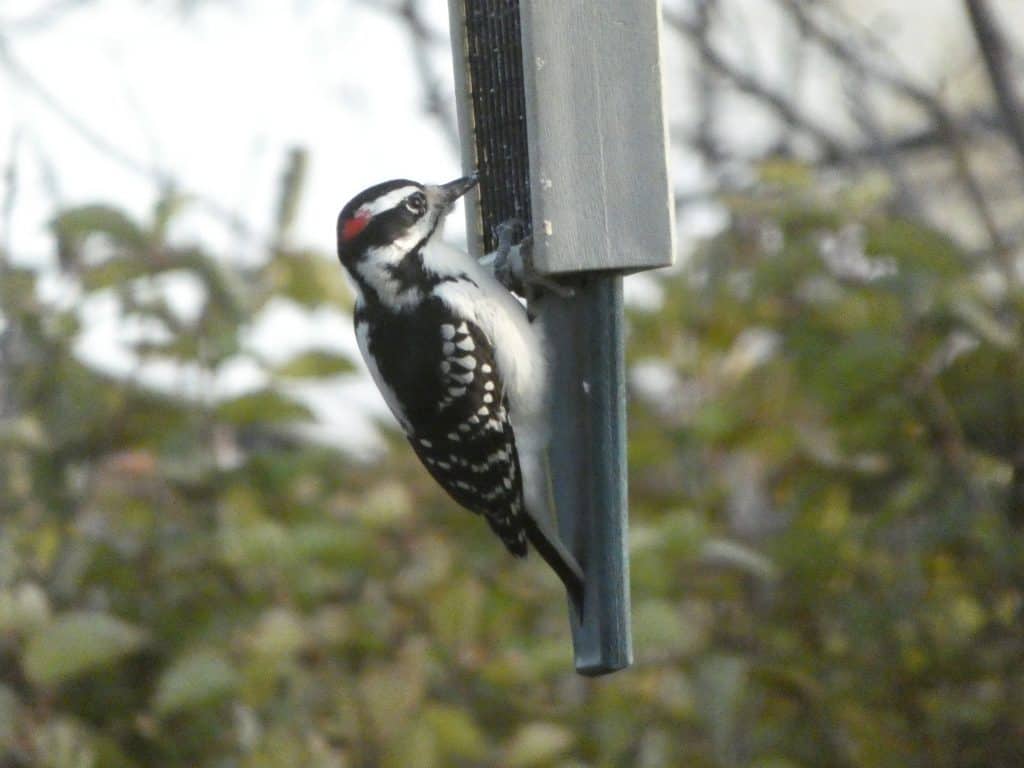
 Bluish jay. Photograph taken with Panasonic Lumix FZ80 fifteen′ away." course="wp-prototype-5804″/>
Bluish jay. Photograph taken with Panasonic Lumix FZ80 fifteen′ away." course="wp-prototype-5804″/>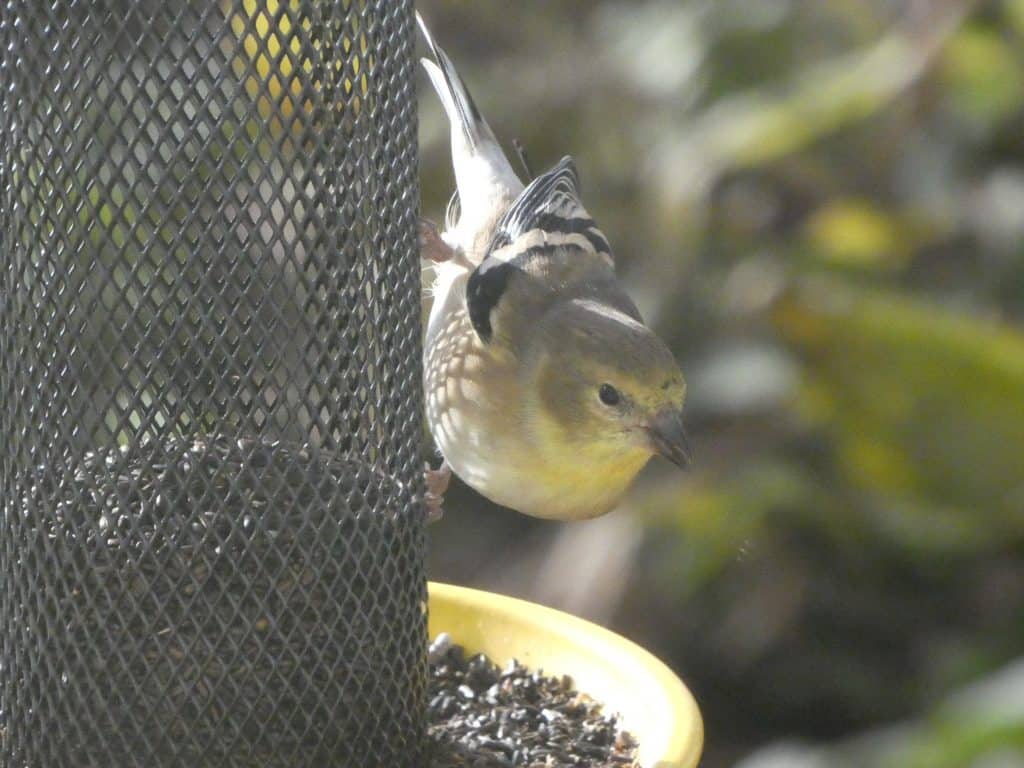
Sony CyberShot RX10IV Review for Birding
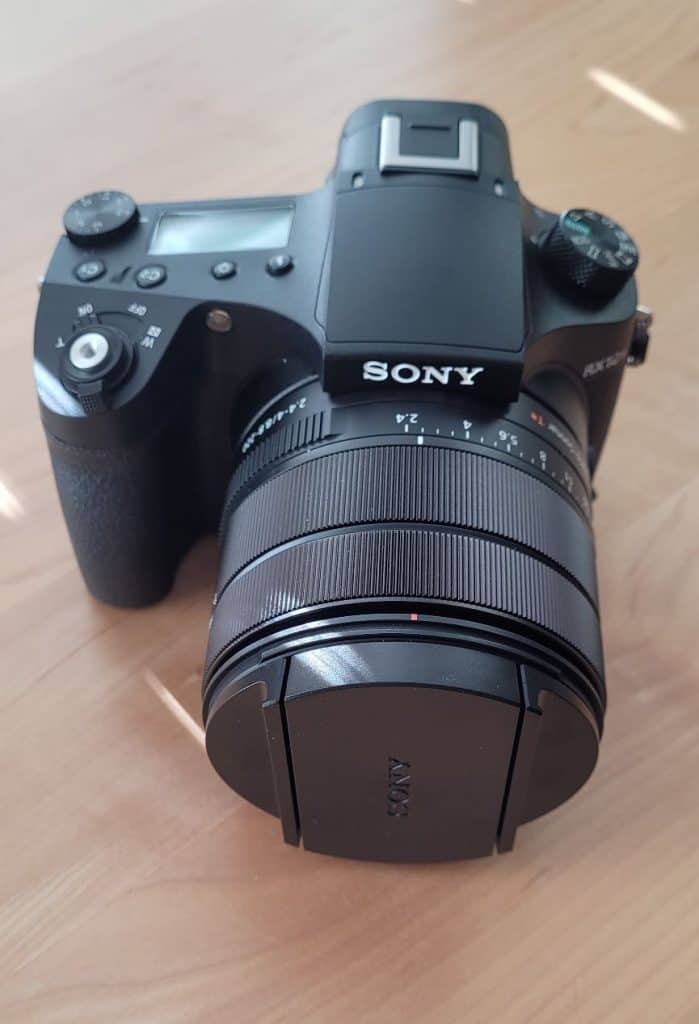
The Sony CyberShot RX10IV is the fastest superzoom camera bachelor (24 fps) and perfect
for the lawn birder that wants neat image quality and a huge multifariousness of nifty images to choose from with each shot.
With the largest sensor of all the superzooms (1″) the resulting image is surrounded by plenty of "space" compared with the smaller sensor cameras. However, a bigger sensor too comes with a higher price tag. The Sony CyberShot RX10IV is the most expensive superzoom – even more than than the ones with amazing zooms (the Nikon Coolpix P950 & P1000).
If you lot want a superzoom camera that nearly has it all (fast, small, light, fast autofocus, great image quality), intend to be within 25′ of the birds, and you don't want to look for the Nikon superzoom to become available, the Sony Cybershot RX10IV may be for you.
Key Features
| Make & Model | Sony CyberShot RX10IV |
| Optical Zoom | 25x |
| Motorcar Focus | Quick |
| Prototype Stabilization | Yes |
| Frame Capture Rate | 24 fps |
| Sensor | i″ BSI CMOS |
Pros & Cons
Pros
- Blazing fast frame capture rate – 24 fps.
- Excellent image quality.
- Skillful autofocus speed to focus on the bird apace.
- The electric current exposure settings are piece of cake to identify in the superlative window.
Cons
- Pricey.
- Doesn't have a Bird mode and so getting started was slower.
Sony CyberShot RX10IV Test Observations
The Sony CyberShot RX10IV doesn't have a Bird mode so I wasn't able to ready it and start shooting right away. This is a minor annoyance just may be central if y'all're new to photography.
With only a 25x optical zoom I needed to get much closer to the birds to go a closeup.
The blazing-fast frame capture rate was immediately noticeable and left me with a huge choice of photos to choose from for a given shot. Besides this feature advantage, I didn't notice any additional attributes that warrant a huge jump in cost from the other superzoom cameras.
I really like the tiptop window which showed the electric current exposure settings without having to
hunt through menus for them.
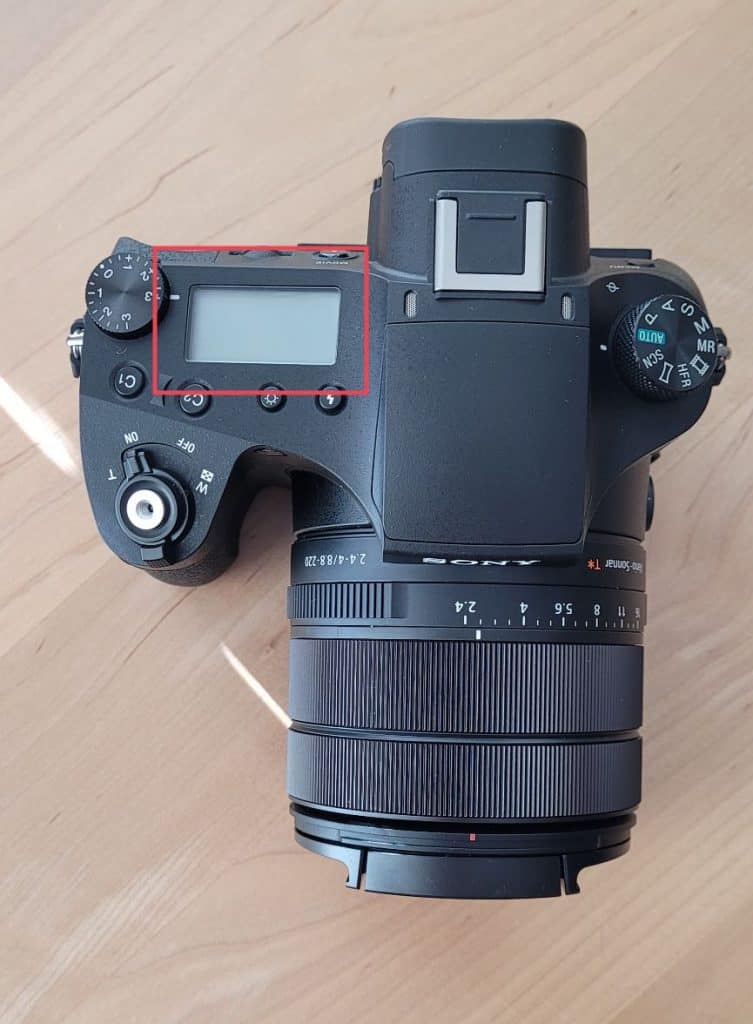
Optical Zoom Altitude Test
Below are the results of the distance testing with the Sony CyberShot RX10IV camera at full zoom.
More Sony CyberShot RX10IV Sample Images
Below are boosted photos taken with the Sony CyberShot RX10IV. They're unedited and mayhap not the best in terms of composition only provide a sample of the photographic camera'southward epitome quality and zoom adequacy.
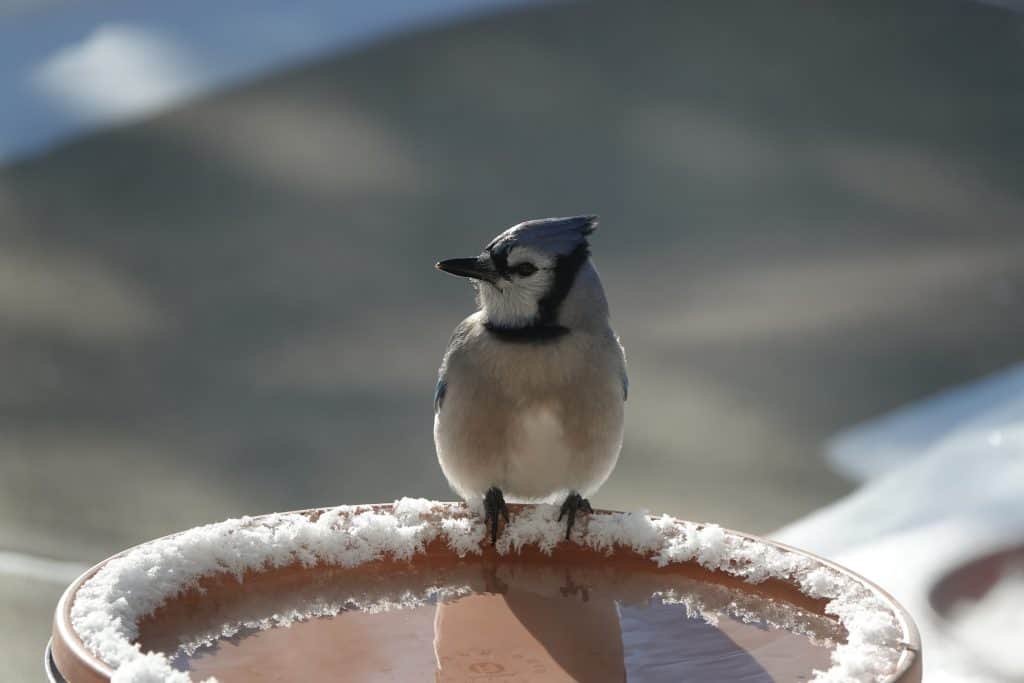
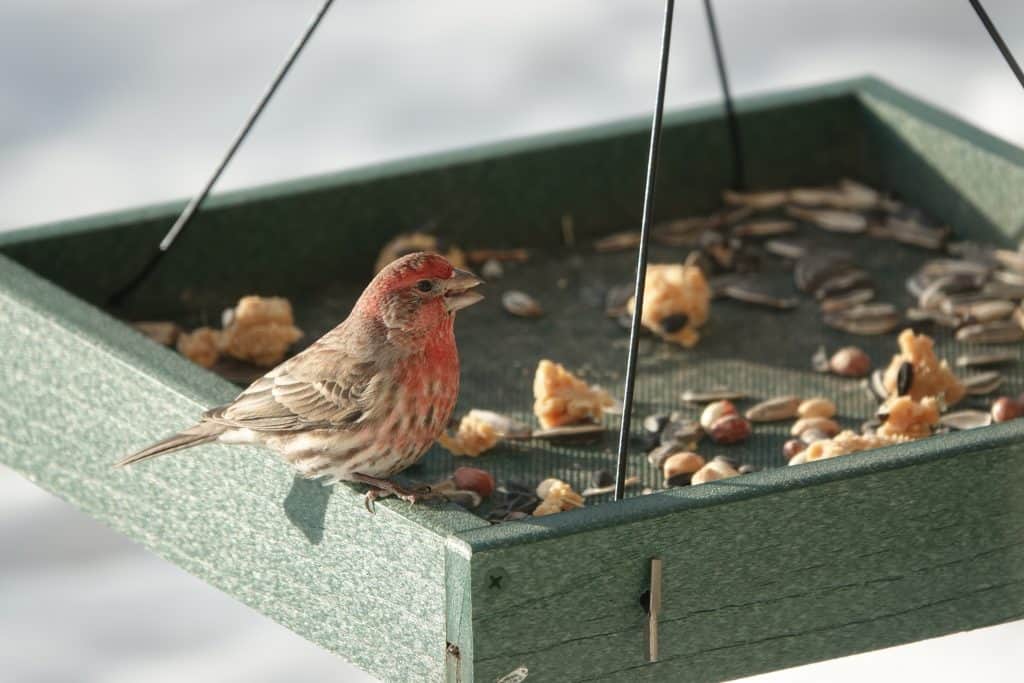
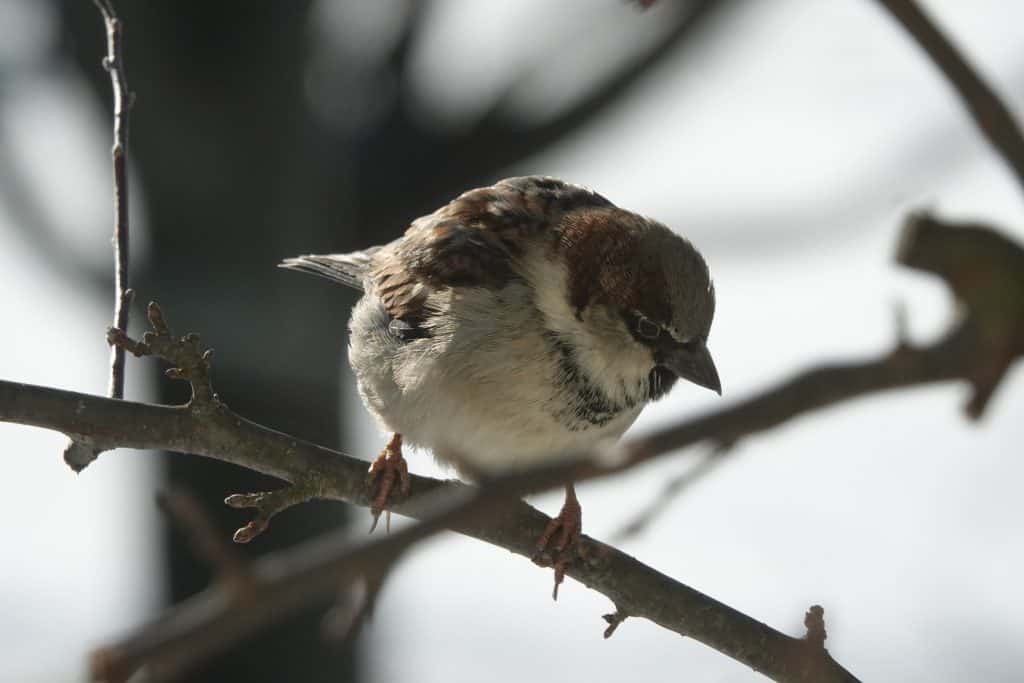
Frequently Asked Questions
How is Bird Photography Unlike from Other Types of Photography?
Bird photography is unique from other types of photography considering the models (birds) are very tiny, appear without detect, and don't stay nonetheless for long. Bird photography requires equipment that quickly zooms in to tiny subjects and focuses very, very fast. It also requires the lensman to be patient and aware of the birds' behavior so they can plan for their inflow while at the same fourth dimension being ready to shoot because you lot may but take i risk.
What's the all-time time to picket birds?
The best time to scout birds is between dawn and x:00 AM when they are about active. When inclement weather is budgeted they will exist agile even longer.
How Can You Tell if a Camera Lens is Zoomed?
Yous can tell if a photographic camera lens is zoomed because the lens is protruded out from the camera trunk.
The Canon SX70 vs Nikon P950 – Which Camera is Ameliorate for Birding?
The Canon SX70 and Nikon P950 are great choices for birding photography.
- Both cameras have the massive zoom adequacy you demand for tiny subjects such as birds (Nikon P950 has 83x zoom while the Canon SX70 has 65x).
- Both cameras have fast autofocus needed for fidgety birds that take off without notice.
- Both cameras likewise take very fast frame capture rates to grab a lot of shots ensuring several volition be keepers (Nikon P950 has 25 fps frame charge per unit while the Canon SX70 has 12 fps).
Deciding betwixt the two cameras for birding comes down to great vs astonishing zoom adequacy, camera size & weight, and how long you lot're willing to expect for the photographic camera to make it at your doorstep.
Choose the Nikon Coolpix P950

If you lot want the maximum zoom bachelor, fastest frame capture rate, are willing to pay a bit more, don't listen a moderately weighty camera, and are willing to expect for it to arrive at your door – cull the Nikon Coolpix P950. Bank check out my full review higher up.
Choose the Canon Powershot SX70 HS

If you want the amazing zoom to capture those tiny birds but don't demand the maximum zoom, fast frame capture rate, lighter & smaller photographic camera, and want information technology immediately – cull the Catechism SX70. Bank check out my full review above.
Conclusion
It can exist overwhelming to find a superzoom camera that suits your needs for bird photography. I was in the same position which is why I dove into testing the top superzoom cameras myself. I learned that whether y'all're an accommodating birder that likes to venture to parks and nature centers to satisfy your "birding" need or someone that but enjoys their lawn, there's a superzoom camera for you. Of all the superzoom cameras I bought and tested, I chose to proceed the Nikon Coolpix P950 for its amazing zoom of 83x and all-around great quality.
Happy Birding!
Source: https://www.onthefeeder.com/best-superzoom-camera-birding/
Posted by: cortezsorm2002.blogspot.com

0 Response to "What Is The Best Bridge Camera With Zoom?"
Post a Comment